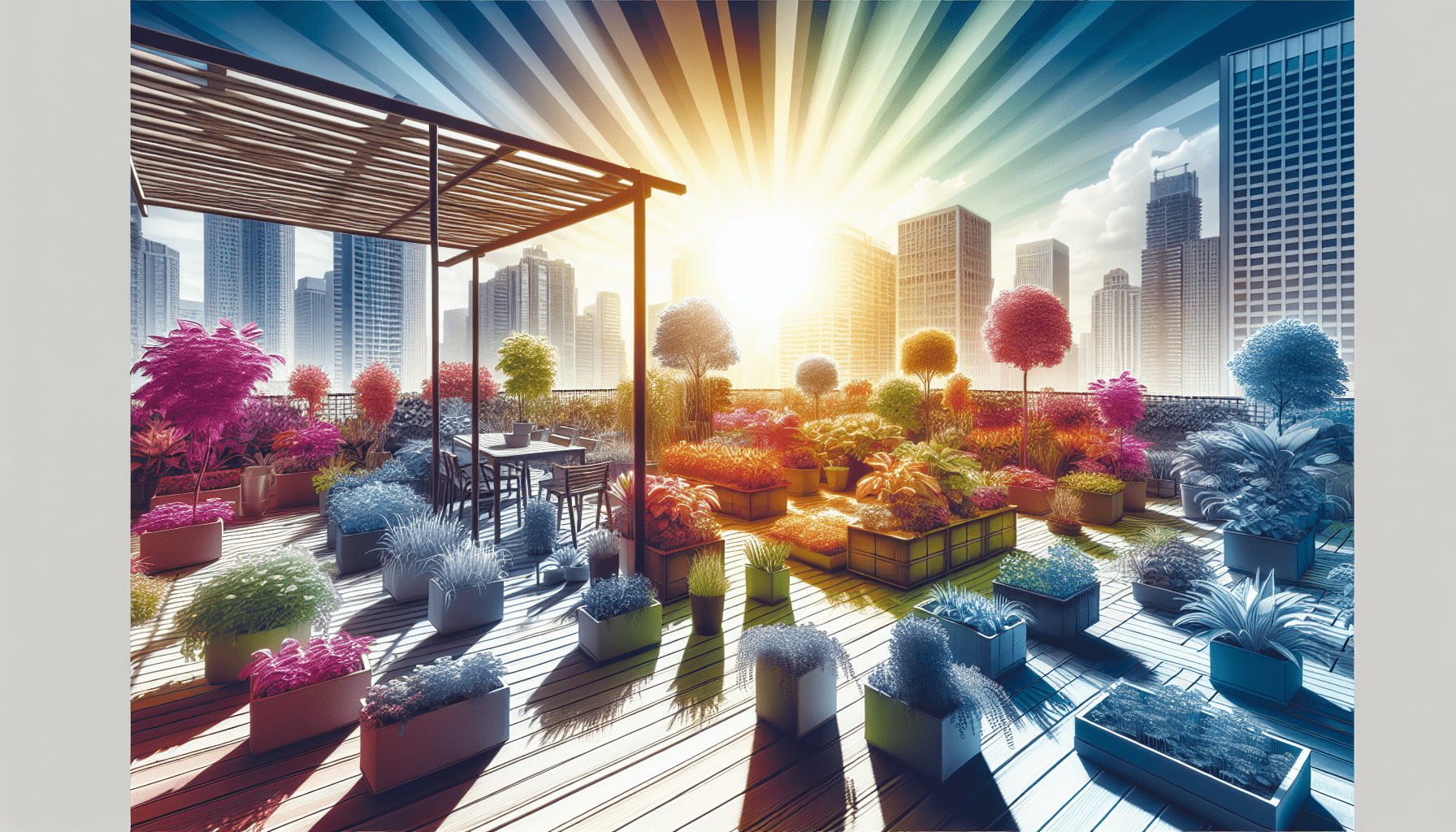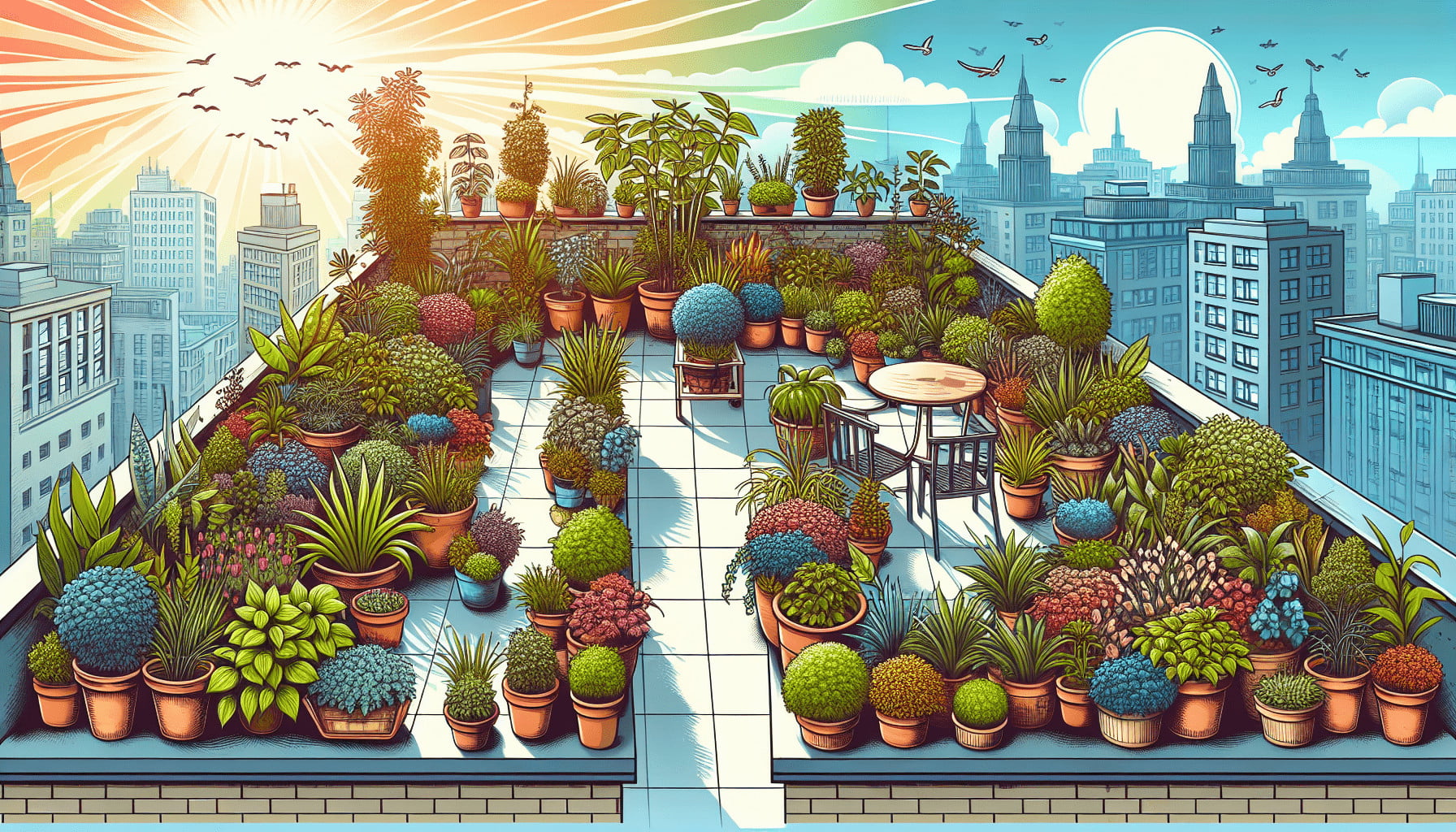Rooftop container gardening is a delightful way to bring greenery to urban spaces, but it comes with its own set of challenges, especially when it comes to managing sunlight and shade. Ensuring your plants receive the right amount of sun can make the difference between a thriving rooftop garden and a struggling one. Factors such as the type of plants, the orientation of your rooftop, and the surrounding structures all play critical roles in how much sunlight and shade your garden will receive. By thoughtfully considering these elements, you can create a vibrant rooftop oasis that flourishes throughout the seasons.
Important Factors to Consider for Sunlight and Shade in Rooftop Container Gardening
Have you ever considered starting a rooftop container garden? Imagine stepping out onto your rooftop and seeing a lush garden filled with a variety of plants, fruits, and vegetables, all maintained in containers. It’s a rewarding and eco-friendly way to grow your own food and beautify your living space. However, one of the critical aspects you need to think about is how sunlight and shade affect your plants.
Let’s dive into the important factors to consider for sunlight and shade in rooftop container gardening, so you can ensure your plants thrive and your garden flourishes.

Understanding Sunlight in Rooftop Gardening
Sunlight is a fundamental factor in gardening. Your rooftop’s exposure to sunlight can significantly influence what you can grow and how well your plants perform.
The Importance of Sunlight
Sunlight is essential for photosynthesis, the process by which plants create energy and grow. Without adequate sunlight, your plants will struggle to thrive. Most garden plants need at least six hours of direct sunlight daily, but some may need even more.
Assessing Sunlight on Your Rooftop
Before you start planting, spend a few days observing how sunlight spreads across your rooftop. Note the areas that receive the most direct sunlight and those that remain shady. This observation helps identify the best spots for placing specific types of plants.
Seasonal Changes in Sunlight
Sunlight intensity and duration change with the seasons. During summer, your rooftop may get more sunlight compared to winter. Understanding these seasonal shifts will help you plan your planting schedule and choose plants that can handle different light conditions throughout the year.
Types of Sunlight Exposure
Not all sunlight is equal. Different plants have different requirements when it comes to the kind of sunlight they thrive in. Here are the main types of sunlight exposure:
Full Sun
Plants that need full sun require at least six to eight hours of direct sunlight daily. Examples include tomatoes, peppers, and most herbs. For full sun plants, place your containers in the sunniest spots on your rooftop.
Partial Sun/Partial Shade
Partial sun plants need around three to six hours of direct sunlight daily, often combined with some shade. Leafy greens like spinach and lettuce or root vegetables like beets fall into this category. Try to position these plants where they can get morning sun and afternoon shade.
Full Shade
Full shade plants require less than three hours of direct sunlight daily. They are ideal for areas of your rooftop that are mostly shaded. Examples include ferns and hostas. These plants often thrive in low light conditions and can add a lush touch to your garden.
Managing Shade in Rooftop Gardening
While sunlight is vital for growth, managing shade is equally crucial. Shade can help protect plants from extreme temperatures and reduce the risk of scorching.
Benefits of Shade
Shade can prevent your plants from overheating and drying out, especially during hot summer days. It also helps in maintaining soil moisture levels, reducing the need for frequent watering. Strategic shading can create a more balanced environment for your plants.
Creating Artificial Shade
Sometimes, natural shade might not be sufficient, and you may need to create artificial shade. You can use shade cloths, umbrellas, or even tall plants to provide shade to more sun-sensitive plants. Creating layers in your garden can optimize growing conditions for a variety of plants.
Moving Containers for Optimum Light and Shade
One of the significant advantages of container gardening is mobility. You can move containers around to optimize their exposure to sunlight and shade as needed. For instance, if a plant starts wilting under too much sun, you can easily move it to a shadier spot.
Plant Selection Based on Light Requirements
Choosing the right plants for your rooftop garden involves considering their light requirements. By matching plants to their preferred light conditions, you ensure they get the energy they need for healthy growth.
Sun-Loving Plants
Here are some plants that thrive in full sun:
| Vegetables | Herbs | Flowers |
|---|---|---|
| Tomatoes | Basil | Sunflowers |
| Peppers | Rosemary | Marigolds |
| Eggplants | Thyme | Lavender |
| Cucumbers | Oregano | Petunias |
| Zucchini | Sage | Coneflowers |
Shade-Tolerant Plants
These plants are well-suited for shady areas:
| Vegetables | Herbs | Flowers |
|---|---|---|
| Lettuce | Mint | Hostas |
| Spinach | Chervil | Impatiens |
| Kale | Coriander | Begonias |
| Beets | Parsley | Ferns |
| Radishes | Cilantro | Coleus |

Designing Your Rooftop Garden with Light and Shade in Mind
A well-designed rooftop garden balances areas of sunlight and shade to create an optimal environment for a diverse range of plants.
Zoning Your Garden
Divide your rooftop into zones based on sunlight exposure. Designate areas for full sun, partial sun/partial shade, and full shade. This approach will help you organize your planting and ensure each plant gets the right amount of light.
Utilizing Vertical Space
Grow upwards to maximize space on your rooftop. Use trellises, vertical planters, and hanging baskets to create more room and optimize light exposure. Tall plants can also provide shade for smaller plants beneath them.
Using Reflective Surfaces
Reflective surfaces can enhance light levels in shaded areas. Consider painting walls white or using light-colored containers to reflect more sunlight onto your plants.
Water Management
Sunlight and shade impact soil moisture levels. Full sun areas tend to dry out faster, requiring more frequent watering. Shade can help conserve moisture, but it’s essential to ensure that shaded areas have proper drainage to avoid waterlogging.
Adapting to Weather Conditions
Weather conditions on rooftops can be more extreme compared to ground-level gardens. Wind, temperature fluctuations, and direct sunlight can present unique challenges.
Protecting from Wind
Rooftops are often more exposed to wind, which can damage plants and dry out soil quickly. Windbreaks such as lattice screens, fencing, or strategically placed taller plants can help protect your garden from strong winds.
Handling Temperature Fluctuations
Temperature changes can be more pronounced on rooftops. Be prepared to protect sensitive plants during sudden cold snaps or heatwaves. Use garden fabric to cover plants during cold weather and mulch to help retain moisture during hot periods.
Rain and Water Management
Rooftops may not always have adequate drainage to handle heavy rain. Ensure your containers have proper drainage holes and use saucers to catch excess water. Consider setting up a rainwater collection system to utilize natural water sources and reduce dependence on tap water.
Plant Care Tips for Rooftop Container Gardening
Proper plant care ensures that your rooftop garden thrives despite the challenges of sunlight and shade.
Soil and Fertilization
Use high-quality potting soil that retains moisture yet drains well. Container plants rely on you for nutrients, so fertilize them periodically with a balanced fertilizer. Organic options like compost or worm castings are also excellent choices.
Watering Techniques
Watering needs can vary based on sunlight and shade levels. Full sun plants might need daily watering during hot periods, while shaded areas may need less frequent watering. Water plants thoroughly and allow the soil to dry slightly between waterings to avoid root rot.
Pruning and Maintenance
Regularly prune your plants to encourage healthy growth and improve air circulation. Remove dead or yellowing leaves to prevent disease. Check plants for pests and treat them promptly to avoid infestations.
Conclusion
Rooftop container gardening is a rewarding endeavor that brings greenery and freshness to urban living spaces. Understanding and managing sunlight and shade are crucial to creating a thriving garden. By assessing your rooftop’s light conditions, selecting the right plants, and employing strategic garden design, you can transform your rooftop into a flourishing oasis. So, roll up your sleeves, get your gardening gloves on, and start planning your vibrant rooftop container garden today!
Remember, gardening is a journey of learning and experimenting, and each rooftop has its unique environment. With patience, creativity, and attention to the factors discussed, your rooftop garden will flourish in both sunlight and shade, providing you with a beautiful and productive green space.
Happy gardening! 🌱
